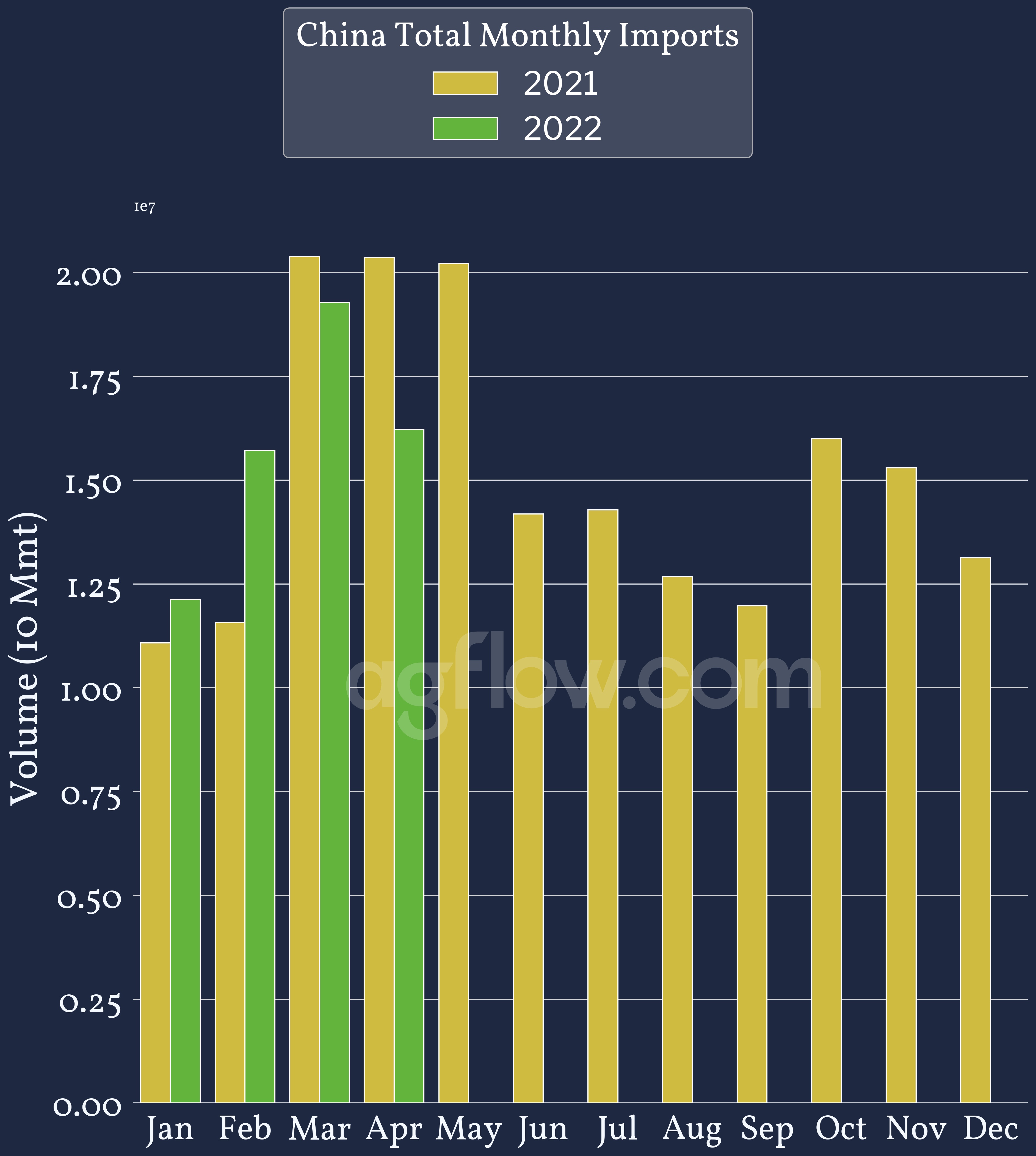Is China Really Slowing Down Imports in 2022
Reading time: 6 minutes
In 2021, China imports surged in the first half of the year, contributing to the global bull market. At the start of Q1 2022, growth continued as Feb Imports increased by 4.1 Mmt YoY due to the early harvest of Brazil Soybean. However, at the end of Q1 2022, import growth is slowing down, with volumes decreasing 1.1 Mmt in Mar & ~5.1 Mmt in Apr YoY. Overall, imports have decreased by 1 Mmt during the period. Is China slowing down on all fronts?
Read also: Year of the Tiger: Is China Going to Pounce on Soybean, Corn & Barley in 2022?
Figure 1: Jan to Apr China Agricultural Imports Growth: 2022 v. 2021
Track Cargos From Brazil, and Up to 14 Other Origins to China
Free & Unlimited Access In Time
Read also: Is Soybean the Winner of the 2022 Vegoils Crisis?
China Imports Between January & April 2022 focused heavily on its top commodities, representing ~92% of all imports. While Soybean imports remained relatively stable, decreasing only by 0.72% YoY, Barley & Wheat imports shrank by 24.4% & 20.4% each. Sorghum is the only top commodity that saw imports growth in the first third of 2022 (+3.4% ⇔ +114 kmt YoY). China also increased Soybean Meal imports by 452%. While US Sorghum is cheaper than its Wheat, Soybean Meal prices surged in Q1 2022. In what capacity do the costs of goods matter to China imports?
Figure 2: Top 5 China Import Commodities by Volume Between Jan & Apr 2022
Track Monthly Imports Growth to China for 47 Commodities and Up to 15 Origins
Free & Unlimited Access In Time
Read also: How Biofuels & Weather Are Going to Impact Your Vegoils Trades In 2022
In Q1 2022, China imported its core commodities from Argentina, Australia, Brazil, & the US. During the period, Australia Wheat remained the cheapest staple commodity, despite prices increasing 13% since Jan, while US Corn prices grew by 27.5% & Sorghum prices gained ~77.5$ in 4 months. Brazil Soybean Meal also gained ~95.6$/mt but remained primarily cheaper than Soybean. Australian Wheat prices drive China Wheat imports. But the domestic metrics explain why, overall, imports shrank. With negative Soybean crush margins & high stocks of Barley, Wheat, & Corn, these commodities came at a lower need, especially as feed demand slowed down.
Figure 3: FOB Spot Prices Between Jan & May 2022
Access +12k Cash Quotes Monthly For China’s Staple Commodities From Up to 71 Origins
Free & Unlimited Access In Time
Read also: Does Less Corn Mean Less Demand in 2022?
China import dynamics have already shifted from 2021 to 2022. In Q1 2022, China imports surged YoY in Feb due to the early Brazil Soybean crop but are slowing down since Mar. Indeed, coming into May, China has only imported 2.1 Mmt in the first week of the month, slowing down the import pace by 60.5% from 2021. Moreover, the 22/23 China Wheat crop is expected to be much lower than in previous years. So far, China has been able to limit imports. However, with limited domestic Wheat supply available, China will have to pick up imports later in the year, at the risk of significantly reducing stocks.
Figure 4: China Monthly Imports Between Jan 2021 & Apr 2022
Track Cargos for 47 Commodities to China From Up to 15 Origins
Free & Unlimited Access In Time
In a Nutshell
Chinese imports started strong in 2022 due to Brazil Soybean early crop. Yet imports decreased overall since the start of the year, specifically for Wheat and Barley, despite profiting from the cheap and plentiful Australian Wheat supply. This loss is due to China’s stocks for these commodities running high and feed demand slowing down with negative pork margins. Surging prices led China to limit imports and use stocks to minimize the ramping inflation. Moreover, China vastly increased its Soybean Meal imports as domestic Soybean crush margins continued thinning down, and Soybean Meal is sensibly cheaper than Soybean, as the less attractive Soybean product.
Nonetheless, China’s imports continue to run low, and the import pace in the first week of May is much slower than in 2021, showing that China is not ready to pick up the pace just yet. ThisWith the new Wheat crop expected to be critically low, China may have to increase imports in the second half of 2022. With the EU and Russian Wheat forecast showing great promise, China may turn towards these origins if the pricing does not turn out to be a deal-breaker.
Read also: Can US Winter Wheat be Attractive in 2022?





